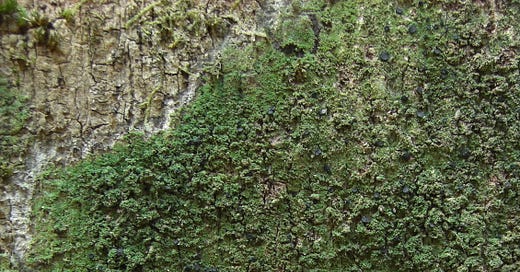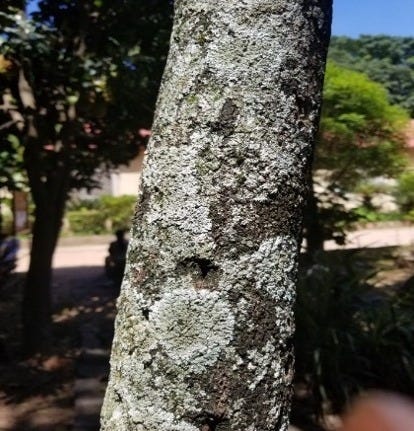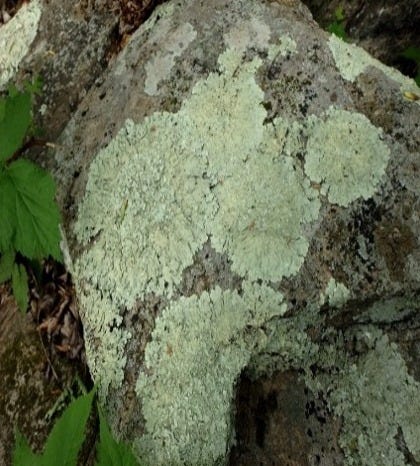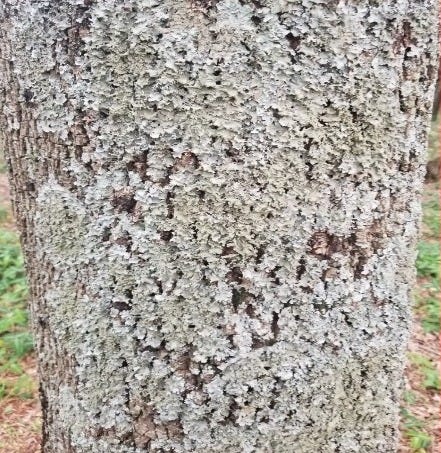Abdul Sannoh on Lichens and Air Pollution
During a fasciniating interview with Abdul Sannoh an experienced Environmental & Radiation Superintendent at Sierra Rutile Limited, with more than 15 years of industry experience. He specializes in environmental management and research, actively contributing to advancements in environmental practices. We discussed his paper “The Use of Lichens as Bio-Indicators and a Cost-Effective Way for Heavy Metals Pollution Monitoring in Ambient Air in the Western Area and Southern Province of Sierra Leone.” to better understand the benefits of this unique environmental monitoring strategy.
“The curiosity of onlookers added to the experience, as many approached with questions about the scraping of tree bark, eager to understand the delicate process we undertook and the care necessary to preserve these fascinating organisms.”
What inspired you to study lichens as bio-indicators of air pollution in Sierra Leone?
In Sierra Leone, where concerns about air pollution have not been thoroughly examined and traditional air quality monitoring methods are not available to evaluate different levels of pollution throughout the country. The study of air pollution using lichens plays a significant role in providing crucial insights into the broader environmental implications and recommend solutions to combat the problems of air pollution.1
Studying lichens as bio-indicators of air pollution in Sierra Leone was inspired to establish the following.
• baseline pollution levels in different locations in Sierra Leone
• assess the differences in the Index of Atmospheric Purity (IAP) in the Western Area and Southern Province of Sierra Leone.
• increase awareness of the elements and sources of air pollution in Sierra Leone.
How does your research contribute to understanding air pollution in the country?
This research enhances our understanding of air pollution in the country (Western Urban & Rural Areas & Southern Province) by pinpointing significant sources of emissions, mapping areas with high pollution levels, assessing the health effects of exposure, and formulating tailored mitigation strategies. These efforts provide valuable insights for policymakers and communities, enabling them to make informed decisions to curb air pollution and safeguard public health.
The research focuses on several key aspects related to air pollution and its impact on public health:
• Source Apportionment: To analyze the presence of heavy metals such as cadmium (Cd), chromium (Cr), cobalt (Co), copper (Cu), iron (Fe), lead (Pb), nickel (Ni), and zinc (Zn),the research used advanced modeling techniques like Energy Dispersive X-Ray Fluorescence (EDXRF) and Atomic Absorption Spectroscopy (AAS). These methods help to determine the contributions of various sources, including vehicles, industrial activities, and agricultural practices, to overall air pollution levels.
• Air Quality Monitoring: Measure pollutant concentrations across different regions, to identify areas experiencing elevated pollution levels.
• Exposure Assessment: The research examines the relationship between air pollution and population demographics, helping us understand which groups are most vulnerable to exposure.
• Policy Evaluation: The research assesses the effectiveness of current air pollution control policies and develops recommendations for new mitigation strategies informed by the research findings.
How this research benefits the country
• Informing Policy Decisions: The findings provide evidence-based insights that aid policymakers in developing strategies to reduce emissions and enhance air quality.
• Prioritizing Mitigation Efforts: By identifying the most significant sources of pollution, better target interventions, such as implementing emission standards or advancing clean energy initiatives.
• Raising Awareness: Communicating the research findings to the public to promote understanding of air pollution issues and encourage behavior changes.
Pollution & Environmental Impact
Your study highlights high levels of heavy metals in urban and rural areas. What do these findings tell us about air pollution sources in Sierra Leone?
Elevated concentrations of heavy metals in both urban and rural regions suggest that sources of air pollution are likely to be varied and extensive. These sources include industrial emissions, vehicle exhaust, agricultural activities, and even natural events such as dust storms, depending on the specific heavy metals identified and their geographical context. This underscores the necessity for comprehensive pollution control strategies that address multiple sectors effectively.
Specific Heavy Metals and Their Potential Sources:
• Lead (Pb): Mainly derived from vehicular exhaust and older industrial processes.
• Cadmium (Cd): Commonly linked to industrial emissions from metal smelting and mining activities.
• Arsenic (As): Often originates from mining, industrial emissions, and certain agricultural practices.
• Mercury (Hg): Primarily produced through coal combustion and various industrial processes.
Implications for Air Pollution Control:
• Targeted Regulations: Understanding the primary sources of heavy metals in specific regions is essential for creating targeted pollution control measures that effectively address the issue.
• Multi-Sector Approach: Successfully tackling air pollution from heavy metals requires coordinated efforts across various sectors, including industry, transportation, and agriculture.
• Monitoring and Enforcement: Consistent monitoring of air quality and strict enforcement of emission standards are vital for managing and reducing heavy metal pollution levels.
4. What are the health and ecological implications of the heavy metal concentrations found in your study?
Heavy metal contamination poses significant risks to both human health and the environment. Below are some of the key implications of the research findings:
Health Implications:
• Skin Toxicity: Contact with heavy metals can cause skin irritation, including rashes.
• Cardiovascular Toxicity: There is evidence that heavy metals can harm the cardiovascular system, leading to various health issues.
• Respiratory Issues: Heavy metals may contribute to respiratory problems such as asthma, chronic cough, shortness of breath, and wheezing.
Ecological Implications:
• Bioaccumulation: Heavy metals can accumulate in fish and other organisms, posing a contamination risk to the food chain.
• Ecosystem Disruption: These contaminants can disrupt local ecosystems and adversely affect wetland organisms.
Did your findings challenge your expectations about pollution in Sierra Leone?
During the research phase of mapping and designing sampling points, I was aware of the regions plagued by elevated levels of pollution. These areas, marked by their deteriorating air quality, pose significant risks not only to human health but also to the well-being of local wildlife. The toxic environment can lead to a myriad of serious health issues, including debilitating eye irritation, chronic respiratory complications, cardiovascular diseases, and, in the most tragic cases, premature mortality. Such alarming disturbances underscore the urgent need for intervention in these affected ecosystems.
What was the most surprising finding from your study?
Lichen's high sensitivity to air pollution was the most surprising findings from the study. These fascinating organisms thrive in a wide range of habitats, from urban environments to untouched wilderness, making them readily accessible for both collection and identification. The morphology of lichen encompassing their unique external structures, colors, and textures displays a remarkable diversity across species. This variation plays a crucial role in pinp
ointing pollution hotspots, allowing researchers to infer the condition of the surrounding environment even in the absence of complex analytical methods. Moreover, utilizing lichens as a cost-effective alternative to traditional air quality monitoring equipment offers a practical solution for effective assessments, alleviating the financial strain often associated with high-tech measurement devices.
Can you explain why lichens are effective bio-indicators of air pollution, particularly for heavy metals?
In contrast to the prohibitively expensive air quality monitoring equipment, utilizing lichens as bio-indicators presents a remarkably cost-effective strategy for evaluating air pollution levels.
Lichens are regarded as highly effective bioindicators of air pollution, particularly in relation to heavy metals. These fascinating organisms absorb nutrients directly from the atmosphere through their entire surface, rendering them exceptionally sensitive to airborne contaminants. As they accumulate heavy metals within their tissues, the presence or absence of certain lichen species in each area offers valuable insight into the surrounding pollution levels. They essentially function as a "living monitor" of air quality, providing real-time feedback on the environmental health of our atmosphere. This unique characteristic not only highlights the involved relationship between lichens and their environment but also underscores their significance in environmental monitoring.
What are the advantages and limitations of using lichens for monitoring air pollution - compared to conventional methods?
Lichens serve as valuable allies in the realm of air pollution monitoring, due to their high sensitivity to various pollutants. These unique organisms can integrate exposure over extended periods, providing a comprehensive picture of air quality changes over time. Their extensive distribution across diverse habitats further enhances their utility as cost-effective, non-invasive bioindicators. However, the use of lichens is not without limitations. Challenges in identifying specific species can complicate the assessment process, while their sensitivity to a range of environmental factors may influence results. Additionally, unlike traditional monitoring methods such as air quality sensors, lichens cannot pinpoint the sources of specific pollutants, which can be a significant drawback in targeted pollution management efforts.
What was your experience like while collecting lichen samples in the field? E.g. were there any: challenges, curious people nearby, memorable moments, peculiarities?
Prior to the collection of lichen samples, I had the privilege of receiving a week-long field training from a distinguished Lichenology expert from the Department of Life Sciences at the Natural History Museum, Cromwell Road in London. This immersive training enriched my understanding of lichen identification and introduced me to fundamental concepts crucial to the field. One particularly memorable moment was when I utilized hand lens to examine the complicated details of various lichens, revealing their unique textures and colors. The curiosity of onlookers added to the experience, as many approached with questions about the scraping of tree bark, eager to understand the delicate process we undertook and the care necessary to preserve these fascinating organisms.
Did you notice any visible differences in the lichens between polluted and cleaner areas?
Indeed, a notable contrast was observed between the lichens surveyed in polluted regions and those thriving in cleaner environments, largely due to the unique physiological traits that render them particularly susceptible to atmospheric contaminants. In the polluted areas, the lichens exhibited striking signs of distress: their vibrant colors faded to dull hues, growth was stunted, and in some cases, entire colonies succumbed to the harsh conditions, leading to their complete desolation. This stark decline serves as a poignant indicator of the environmental impact of pollution on these sensitive organisms.
What was it like working with the Institut National des Sciences et Techniques Nucléairesin Madagascar for laboratory analysis?
Collaborating with the Institut National des Sciences et Techniques Nucléaires (INSTN) in Madagascar for laboratory analysis is characterized by a deeply engaging and technically enriching experience. It capitalized on cutting-edge techniques to conduct complex analyses, particularly in vital fields such as environmental air quality monitoring. This partnership thrives on the exchange of knowledge and expertise, fostering a dynamic atmosphere for scientific discovery.
What steps should be taken to reduce heavy metal pollution from industrial and vehicular sources?
To combat the pervasive issue of heavy metal pollution emanating from industrial activities and vehicular emissions, a multifaceted approach is essential. This involves the establishment of rigorous regulations coupled with diligent enforcement to curtail industrial emissions. It is equally important to advocate for the adoption of cleaner technologies and sustainable fuel sources that minimize environmental impact.
Proper management of waste is crucial, ensuring that hazardous materials are disposed of safely and effectively. Additionally, implementing advanced emission control systems on vehicles can significantly reduce the release of toxic substances into the atmosphere. Promoting recycling and the reuse of metals is another vital component, helping to conserve resources while reducing the demand for mining and processing new materials.
Moreover, there is a pressing need for ongoing research and development aimed at uncovering innovative remediation techniques that can restore contaminated environments. Lastly, public awareness campaigns play a pivotal role in educating communities about the dangers associated with heavy metal pollution, fostering a culture of environmental stewardship and proactive engagement in pollution prevention.
Could nature-based solutions help mitigate air pollution in Freetown and beyond?
Yes, nature-based solutions play a crucial role in enhancing air quality by effectively removing pollutants, sequestering carbon, and mitigating greenhouse gas emissions. These strategies encompass a variety of initiatives, including the restoration of damaged ecosystems, the establishment of vibrant green spaces, and the implementation of green infrastructure.
In addition to nature-based solutions, individual actions can significantly mitigate air pollution. Consider the following practices: drive less, keep your car in good repair, use less energy, plant and care for trees, switch to electric or hand-powered lawn equipment, limit backyard fires, walk or ride a bike when possible, take public transportation, organize errands into one trip and accelerate gradually and obey the speed limit
How do you envision the future of environmental monitoring in Sierra Leone? Does it involve lichens?
YES, because lichens are valuable bio-indicators due to their high sensitivity to air pollution. They absorb nutrients directly from the atmosphere and are vulnerable to pollutants such as sulfur dioxide and nitrogen oxide. This sensitivity makes them effective markers for assessing changes in air quality.
One of the advantages of using lichens is their accessibility and ease of monitoring. They can be found in diverse habitats and are relatively simple to collect and identify. This facilitates widespread monitoring efforts across various regions in Sierra Leone.
Additionally, studying the distribution and abundance of different lichen species can help researchers identify pollution hotspots. By analyzing where certain species thrive or decline, it becomes possible to pinpoint areas with elevated levels of air pollution.
Furthermore, employing lichens as bio-indicators presents a cost-effective alternative to conventional air quality monitoring equipment. This approach allows for effective air quality assessments without the financial burden of high-tech devices.
What advice would you give to aspiring researchers in Sierra Leone who are interested in Environmental Science?
For aspiring environmental science researchers in Sierra Leone, it is crucial to cultivate a deep understanding of local ecological systems and cultural contexts. Engaging meaningfully with the community should be a top priority, allowing researchers to gain valuable insights and foster trust. Building research capacity can be significantly enhanced through collaborative efforts with local institutions and international partners, providing a platform for knowledge exchange and skill development. Researchers should prioritize robust and contextually relevant data collection methods that reflect the unique environmental challenges of the region. Furthermore, it is essential to advocate for policy reforms that address critical environmental issues facing Sierra Leone, such as the alarming rates of deforestation, the detrimental impacts of mining activities, and the pressing challenges posed by climate change. By taking a comprehensive and community-driven approach, researchers can contribute to sustainable solutions that benefit both the environment and the people of Sierra Leone.
Check out Abdul’s Publications
1. Abdul Sannoh and Ronnie A.D Frazer-Williams (2023). The Use of Lichens as Bio-Indicators and a Cost-Effective Way for Heavy Metals Pollution Monitoring in Ambient Air in the Western Area and Southern Province of Sierra Leone. BOOK OF PROCEEDINGS: Educational Research in Sub-Saharan Africa, pp. 297-309.
2. OE Abiye, CE Ugwumadu, AJ Kamara, JP Felizardo, A Sannoh (2021). Sensitivity Calibrations of K-and L-shell X-ray Lines for Elemental Analysis of Air Particulate Samples Using a Handheld XRF Spectrometer. Aerosol Science and Engineering, vol. 5, issue 2, pp. 127-135. DOI:10.1007/s41810-021-00089-3.Publication at: https://www.researchgate.net/publication/348715419
“Over the past few decades, a range of innovative techniques has emerged for utilizing lichens as biomonitors or bioindicators, providing valuable insights into air pollution levels and the overall health of forest ecosystems. Lichens have proven to be effective in tracking the dispersion of heavy metals released from industrial point sources and vehicular emissions. However, this promising approach has yet to be explored in Sierra Leone. This study embarks on a comprehensive examination of lichens as bio-indicators for air quality across the diverse landscapes of the Western Area, encompassing both urban and rural settings, as well as the Southern Province, specifically within Bo and Bonthe Districts in Sierra Leone.
Two distinct methodologies were employed in the lichen biomonitoring investigation. The first focused on unraveling patterns in lichen community composition along a well-defined pollution gradient, while the second involved quantifying heavy metal concentrations in lichen samples collected during both wet and dry seasons in Sierra Leone. These methodologies, widely utilized in Europe and Asia, represent a pioneering application in the African context, aiming to bridge the knowledge gap in this region.
To assess the presence of heavy metals, including Cadmium (Cd), Chromium (Cr), Cobalt (Co), Copper (Cu), Iron (Fe), Lead (Pb), Nickel (Ni), and Zinc (Zn), the study employed advanced analytical techniques such as Energy Dispersive X-Ray Fluorescence (EDXRF) and Atomic Absorption Spectroscopy (AAS). An active biomonitoring effort featured the collection of commonly occurring foliose lichen species, specifically Dirinaria Applanata (Fee) D.D. Awasth, from various carefully selected sites. Each sample was gathered from trees with a diameter ranging from 30 to 70 cm and heights between 2 to 5 meters, ensuring a standardized approach to sample collection.
The collected lichen samples were dried and then subjected to digestion to determine the concentrations of the aforementioned heavy metals at the Institut National des Sciences et Techniques Nucleaires (INSTN) on the campus of the University Ankatso in Antananarivo, Madagascar. The EDXRF method primarily served as a qualitative analysis tool, while the AAS method enabled precise quantitative determination of metal concentrations.
Given that samples were collected from locations with minimal exposure to pollution, this study facilitated a comparative analysis of air quality between areas with high and low levels of pollution. The findings underscore the effectiveness of the lichen biomonitoring approach as a valuable instrument for tracking heavy metal air pollution in Sierra Leone. Additionally, this research provides critical baseline data that will inform future investigations into the impact of air pollution on lichen communities, thereby contributing to environmental monitoring efforts in the region.” - Abdul Sannoh







